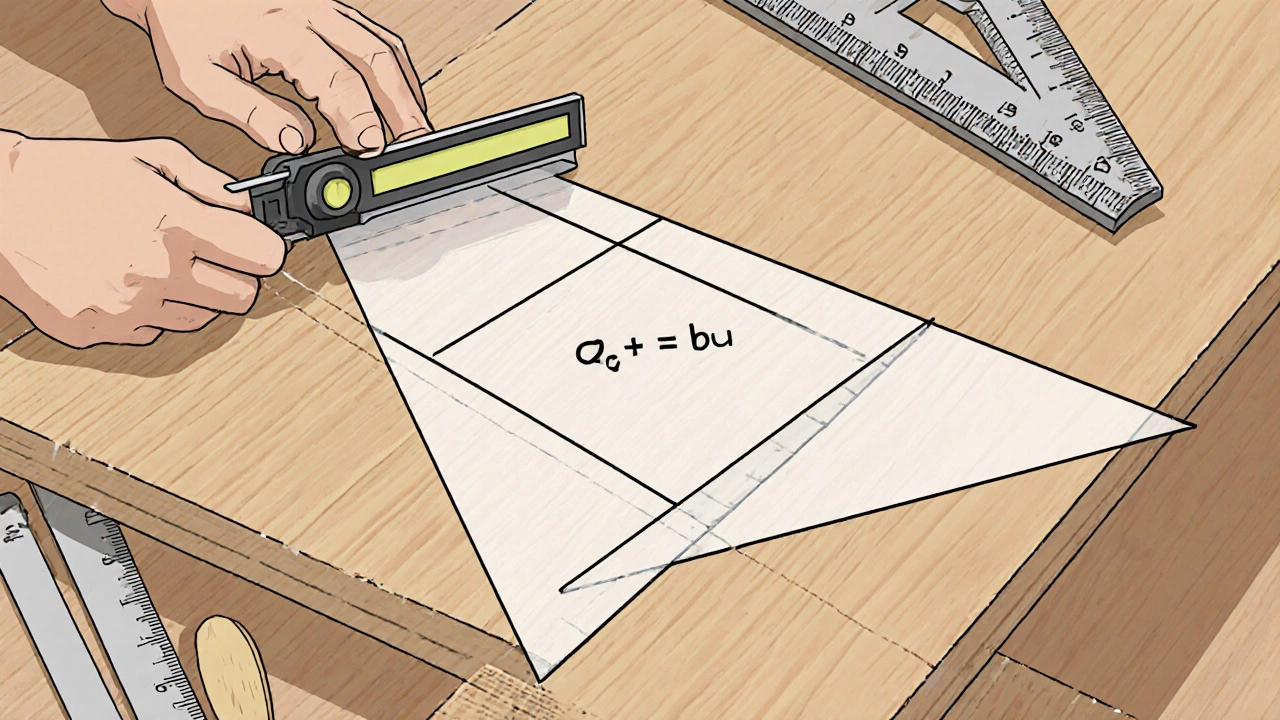Carpentry Stair Stringer Calculator
This calculator helps you determine the diagonal length and angle for stair stringers using the Pythagorean theorem:
Diagonal² = rise² + run²
From the article: "Stair stringer layout (rise & run) - Pythagorean theorem"
Results
Diagonal Length (Stringer Length):
0.00 inches
Angle of Incline:
0.00°
Formula used:
Diagonal = √(rise² + run²)
When you hear the word "carpentry," the first thing that might pop into your head is a hammer, a saw, and a lot of wood shavings. But underneath those practical tools lives a quieter partner: mathematics, the set of numbers and relationships that makes every cut, joint, and finish possible.
What kind of math shows up on a job site?
Most beginners assume they need a college‑level calculus degree to become a carpenter. In reality, the math you use daily is far more approachable. Think of it as a toolbox of geometry, simple arithmetic, and a dash of trigonometry. Here’s a quick rundown of the main concepts:
- Basic arithmetic - adding up lengths, subtracting waste, multiplying dimensions to get area or volume.
- Fractions and decimals - wood is sold in fractions of an inch; you’ll convert 1/8" to .125" regularly.
- Measurement conversion - shifting between metric and imperial, especially on mixed‑material projects.
- Geometry - understanding squares, rectangles, circles, and triangles to lay out frames or arches.
- Trigonometry (basic) - applying the Pythagorean theorem to find diagonal cuts and using sine/cosine for roof pitches.
- Proportions and ratios - scaling plans up or down, creating templates, and mixing concrete or finishes.
How much math do you really need?
Think of the math required as three layers:
- Core calculations - the everyday stuff you’ll do on every job: measuring, adding, converting.
- Specialty calculations - the occasional tasks that need geometry or a simple trigonometric formula, like stair stringer cuts.
- Advanced design work - rare for field carpenters, but common for joinery designers or remodel planners who read detailed blueprints.
Most carpenters operate comfortably within the first two layers. The third layer usually belongs to designers, architects, or specialized CNC programmers. If you can comfortably add, subtract, multiply, divide, and work with fractions, you already have the foundation for a solid carpentry career.
Everyday Math in Action: Real‑World Examples
Let’s walk through a few typical jobs and see the math behind them.
| Task | Math Concept | Quick Formula |
|---|---|---|
| Cutting a 2×4 to a specific length | Basic arithmetic | Desired length = total length-waste |
| Finding the amount of plywood for a wall | Area calculation | Area = width×height (in sqft) |
| Stair stringer layout (rise & run) | Pythagorean theorem | Diagonal² = rise² + run² |
| Roof pitch for a shed | Basic trigonometry | Pitch = rise ÷ run (or use tan⁻¹ for angle) |
| Mixing a concrete batch | Ratios & proportions | 1part cement : 2parts sand : 3parts aggregate |
Notice how each example relies on a single, easy‑to‑remember formula. The trick is internalizing these patterns so you don’t need a calculator for every cut.

Tools That Help You Do the Math
You don’t have to be a math whiz because the trade offers plenty of helpers:
- Tape measure - the most fundamental tool; practice reading it in fractions.
- Speed square - quickly marks 45° cuts and helps with stair calculations.
- Framing square - perfect for checking right angles (3‑4‑5 triangle method).
- Protractor - measures angles for roof pitches when a speed square isn’t enough.
- Calculator or smartphone app - saves time on larger estimations, but you still need to understand the underlying math.
Pick the right tool for the job, and let it do the heavy lifting. Over time you’ll develop an instinct for which math step is needed before you even pick up the tool.
Learning the Math Without Getting Overwhelmed
If you’re new to the trade, here’s a three‑step plan to get comfortable with the numbers:
- Master the basics - Spend a week measuring everything around your workshop. Convert between inches, feet, and millimetres; practice adding fractions of an inch.
- Apply geometry to real projects - Build a simple picture frame. Use a framing square to check 90° corners, then calculate the perimeter for the moulding length.
- Introduce one advanced concept at a time - Try a stair stringer once you’re confident with the Pythagorean theorem. Use an online calculator to verify, then do the same calculation by hand for reinforcement.
Remember, the goal isn’t to become a mathematician; it’s to use the right amount of math to make each cut accurate the first time.
Common Math Mistakes and How to Avoid Them
Even seasoned carpenters slip up. Here are the top pitfalls and quick fixes:
- Skipping the waste factor - Always add 5‑10% extra material when ordering. It prevents costly last‑minute trips.
- Mixing up fractions - Use a fraction chart or a digital ruler that flashes decimals; double‑check each reading before cutting.
- Assuming 90° when it’s not - Verify every corner with a framing square; walls settle, and a “perfect” corner can be slightly off.
- Incorrect pitch conversion - When converting roof pitch to degrees, remember that a 4:12 pitch equals about 18.4°. A quick tan⁻¹ calculation clears the confusion.
- Relying solely on memory for big numbers - Write down key dimensions on a job sheet; a short note prevents costly re‑cuts.
Keeping a small notebook or a digital note app on site can catch many of these errors before they become waste.

When to Call in a Specialist
There are scenarios where the math goes beyond what most carpenters handle daily:
- Complex curvature work (e.g., custom staircases with spiral geometry).
- Structural engineering calculations for load‑bearing walls.
- Advanced CNC programming that uses coordinate geometry and multi‑axis math.
In these cases, collaborating with a structural engineer, an architect, or a CNC specialist ensures safety and precision.
Bottom Line: Is Carpentry a Lot of Math?
The short answer: carpentry math is present, but it’s far less intimidating than the stereotype suggests. You’ll spend most of your time with basic arithmetic, fractions, and practical geometry. A handful of specialty formulas - like the Pythagorean theorem - appear occasionally, and you can rely on simple tools and apps for the rest.
If you’re comfortable measuring, adding, and visualising shapes, you have everything you need to start. The rest is just practice and a willingness to pick up a calculator when the job calls for it.
Frequently Asked Questions
Do I need to know algebra to be a carpenter?
Algebra is rarely required on the shop floor. The main math skills are measurement, fractions, and basic geometry. Algebra may appear in cost estimating software, but you can handle that with built‑in calculators.
How often do carpenters use the Pythagorean theorem?
It shows up most often when cutting diagonal supports, stair stringers, or roof rafters. If you work mainly on framing or finish work, you might only use it a few times a month.
Can a smartphone replace a speed square?
A phone can give you the angle, but a speed square is quicker for marking 45° or 90° cuts on the job site. Most carpenters keep both - the phone for calculations, the square for fast marking.
What’s the best way to improve my fraction skills?
Practice with real lumber. Measure a 2×4, note the length in inches and fractions, then add up pieces to reach a target length. Repeating this on actual material builds confidence much faster than abstract exercises.
When should I order extra material?
Add 5‑10% extra for most projects. For complex cuts or custom pieces, increase the waste factor to 15% to account for errors and grain direction.





Write a comment